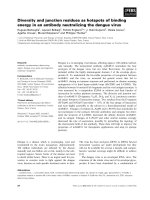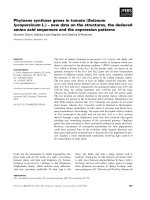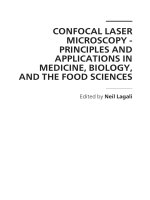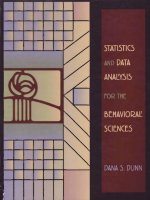CONFOCAL LASER MICROSCOPY - PRINCIPLES AND APPLICATIONS IN MEDICINE, BIOLOGY, AND THE FOOD SCIENCES doc
Bạn đang xem bản rút gọn của tài liệu. Xem và tải ngay bản đầy đủ của tài liệu tại đây (34.1 MB, 244 trang )
CONFOCAL LASER
MICROSCOPY -
PRINCIPLES AND
APPLICATIONS IN
MEDICINE, BIOLOGY,
AND THE FOOD SCIENCES
Edited by Neil Lagali
Confocal Laser Microscopy - Principles and Applications in Medicine, Biology, and the Food
Sciences
/>Edited by Neil Lagali
Contributors
Neil Lagali, Beatrice Bourghardt Peebo, Johan Germundsson, Ulla Eden, Reza Danyali, Per Fagerholm, Marcus Rinaldo,
Rita Marchi, Emi Nishijima Sakanashi, Herrera, Marc Navarro, Jun Fujita, Natsuko Hemmi, Shugo Tohyama, Tomohisa
Seki, Yuuichi Tamura, Keiichi Fukuda, Akira Kobayashi, Enzo Di Iorio, Gary Chinga-Carrasco, Magnus B. Lilledahl,
Catharina Davies, M. Vitoria Bentley, Anjali Basil, Wahid Wassef
Published by InTech
Janeza Trdine 9, 51000 Rijeka, Croatia
Copyright © 2013 InTech
All chapters are Open Access distributed under the Creative Commons Attribution 3.0 license, which allows users to
download, copy and build upon published articles even for commercial purposes, as long as the author and publisher
are properly credited, which ensures maximum dissemination and a wider impact of our publications. After this work
has been published by InTech, authors have the right to republish it, in whole or part, in any publication of which they
are the author, and to make other personal use of the work. Any republication, referencing or personal use of the
work must explicitly identify the original source.
Notice
Statements and opinions expressed in the chapters are these of the individual contributors and not necessarily those
of the editors or publisher. No responsibility is accepted for the accuracy of information contained in the published
chapters. The publisher assumes no responsibility for any damage or injury to persons or property arising out of the
use of any materials, instructions, methods or ideas contained in the book.
Publishing Process Manager Oliver Kurelic
Technical Editor InTech DTP team
Cover InTech Design team
First published March, 2013
Printed in Croatia
A free online edition of this book is available at www.intechopen.com
Additional hard copies can be obtained from
Confocal Laser Microscopy - Principles and Applications in Medicine, Biology, and the Food Sciences,
Edited by Neil Lagali
p. cm.
ISBN 978-953-51-1056-9
free online editions of InTech
Books and Journals can be found at
www.intechopen.com
Contents
Preface VII
Section 1 Applications in Medicine 1
Chapter 1 Practical Application of Confocal Laser Scanning Microscopy for
Cardiac Regenerative Medicine 3
Jun Fujita, Natsuko Hemmi, Shugo Tohyama, Tomohisa Seki,
Yuuichi Tamura and Keiichi Fukuda
Chapter 2 The Use of Confocal Laser Microscopy to Analyze Mouse
Retinal Blood Vessels 19
David Ramos, Marc Navarro, Luísa Mendes-Jorge, Ana Carretero,
Mariana López-Luppo, Víctor Nacher, Alfonso Rodríguez-Baeza and
Jesús Ruberte
Chapter 3 In Vivo Biopsy of the Human Cornea 39
Akira Kobayashi, Hideaki Yokogawa and Kazuhisa Sugiyama
Chapter 4 Laser-Scanning in vivo Confocal Microscopy of the Cornea:
Imaging and Analysis Methods for Preclinical and Clinical
Applications 51
Neil Lagali, Beatrice Bourghardt Peebo, Johan Germundsson, Ulla
Edén, Reza Danyali, Marcus Rinaldo and Per Fagerholm
Chapter 5 Laser Scanning Confocal Microscopy: Application in
Manufacturing and Research of Corneal Stem Cells 81
Vanessa Barbaro**, Stefano Ferrari**, Mohit Parekh, Diego Ponzin,
Cristina Parolin and Enzo Di Iorio
Chapter 6 Confocal Laser Scanning Microscopy as a Tool for the
Investigation of Skin Drug Delivery Systems and Diagnosis of
Skin Disorders 99
Fábia Cristina Rossetti, Lívia Vieira Depieri and Maria Vitória Lopes
Badra Bentley
Chapter 7 Allergic Contact Dermatitis to Dental Alloys: Evaluation,
Diagnosis and Treatment in Japan — Reflectance Confocal
Laser Microscopy, an Emerging Method to Evaluate Allergic
Contact Dermatitis 141
Emi Nishijima Sakanashi, Katsuko Kikuchi, Mitsuaki Matsumura,
Miura Hiroyuki and Kazuhisa Bessho
Chapter 8 Confocal Endomicroscopy 157
Anjali Basil and Wahid Wassef
Section 2 Applications in the Biological Sciences 167
Chapter 9 Three-Dimensional Visualization and Quantification of
Structural Fibres for Biomedical Applications 169
Magnus B. Lilledahl, Gary Chinga-Carrasco and Catharina de Lange
Davies
Chapter 10 Confocal Microscopy as Useful Tool for Studying Fibrin-Cell
Interactions 189
Rita Marchi and Héctor Rojas
Section 3 Applications in Food Science 201
Chapter 11 Applications of Confocal Laser Scanning Microscopy (CLSM)
in Foods 203
Jaime A. Rincón Cardona, Cristián Huck Iriart and María Lidia
Herrera
ContentsVI
Preface
Science often grows exponentially from certain key insights, and the insight Marvin Minsky
had in 1955 is no exception. While working as a postdoctoral fellow at HarvardUniversity,
Minsky sought a method to reduce the high level of light scatter that made high contrast imag‐
ing of thick specimens impossible by standard light microscopy. He realized that an arrange‐
ment of lenses having conjugate focal planes (hence the term ‘confocal’), with a specimen and
a pinhole placed at these opposite planes, could serve to reject the light that was scattered out-
of-plane at the specimen. The result was a conceptually simple yet powerful method that not
only improved the contrast of an image, but that also enabled adjacent serial optical sections of
tissue to be analysed. Although these benefits were readily apparent in early confocal micro‐
scope systems employing white light sources, it was the advent of inexpensive diode lasers
emitting at various wavelengths that dramatically improved the image contrast, fluorophore
targeting, and the axial resolution of the confocal system. Today, laser-scanning confocal mi‐
croscopy is ubiquitous in biomedical, biological, and non-biological research. Its versatility
has ensured its widespread popularity, and the confocal technique has spawned many var‐
iants, aiming to improve detection, resolution, and contrast.
Laser-based confocal microscopy has provided the basic platform upon which more exotic
laser microscopy techniques have been developed. These techniques improve on some of
the limitations of confocal microscopy, by exploiting non-linear effects of laser light to pro‐
vide advantages such as thinner optical sectioning, non-damaging low-energy excitation,
and imaging with intrinsic molecular contrast. While non-linear techniques undoubtedly
improve our ability to extract information from specimens and can provide unmatched im‐
age quality and information in certain situations, laser confocal microscopy is still the most
widely applicable laser microscopy technique in use today. Indeed, this volume is a testa‐
ment to this broad applicability, describing the use of laser confocal techniques to address
diverse questions in medicine, biology, and the non-biological sciences.
In the biomedical field, confocal microscopy is crucial for examining single cells labelled
with multiple fluorescent probes, by means of serial confocal examination with multiple ex‐
citation wavelengths. This technique is eloquently described in Chapter 1, where the authors
detail insights gained into stem cell-based cardiac regenerative therapy. Laser confocal tech‐
niques such as thin sectioning, 3D image reconstruction, and spectrally-resolved fluorescent
detection are discussed. Chapter 2 describes the application of high resolution sectioning
and multi-channel fluorescent detection to elucidate the detailed morphology and structural
composition of retinal blood vessels in the mouse – a model commonly used to study eye
disease and angiogenesis.
Chapters 3, 4, and 5 concern the use of laser confocal microscopy in the cornea. Because it is
a thin, transparent tissue that is externally accessible, the cornea has become a model organ
for examination by laser confocal microscopy. These chapters describe the use of an in vivo
variant of laser confocal microscopy to study the live cornea in patients, as well as in pre‐
clinical animal models. Additionally, corneal cells and tissues can be studied in vitro and ex
vivo by similar techniques, for example, to gain insights into stem cell cultivation for corneal
regenerative medicine. The widespread use of laser confocal microscopy in ophthalmology
has led to the development of sophisticated image acquisition and analysis techniques,
which can be readily exported to other fields.
Another external tissue amenable to examination is the body’s largest organ, the skin. Chap‐
ter 6 comprehensively describes the use of laser confocal microscopy to analyze skin biopsy
specimens and the skin of live patients in vivo. Diagnosis of melanomas, carcinomas, der‐
matitis, and keratosis can be aided by the confocal microscope. Additionally, the dynamics
and efficacy of drug delivery through the skin can be investigated through laser confocal
microscopic detection of fluorescently-labelled drugs or tagged nanoparticles. The condition
of dermatitis, however, can also occur in the oral cavity, and the problem of allergy to dental
alloys can cause a particularly severe form of dermatitis. Chapter 7 addresses this topic, de‐
scribing the nature and extent of the condition. Laser confocal microscopy is presented as a
new tool to improve the objectivity of grading the severity of allergic skin reactions to vari‐
ous dental metals.
For internal organs of the body not externally accessible to in vivo confocal microscopic ob‐
servation, confocal laser endomicroscopy is an emerging technique that combines traditional
endoscopic imaging with the high magnification, cellular level resolution and targeted fluo‐
rescence excitation provided by confocal microscopy. In Chapter 8, in vivo monitoring and
diagnosis of conditions of the gastrointestinal tract by confocal laser endomicroscopy is de‐
scribed. An excellent correlation between confocal images and histopathology is possible in
conditions such as Barrett’s esophagus.
Within the biological sciences, structural fibers such as collagen, elastin, and cellulose form
the scaffold of various organs and structures in humans, animals, or plants. These fibers
form a matrix that interacts with cells and provides a medium for molecular signaling. In
Chapter 9, 3D visualization and quantification of structural fibers is described, along with
emerging non-linear laser microscopic imaging techniques. For these sophisticated imaging
techniques, powerful image analysis techniques for data extraction are also discussed, in‐
cluding the use of various transforms and gradient methods. In Chapter 10, another type of
biological matrix, that produced by fibrin, is discussed. The fibrin matrix and fibrin-cell
interactions are probed in three dimensions by the use of laser confocal microscopy, to in‐
vestigate pheonmena that can have wide ranging consequences for studying the processes
of clotting, inflammation, wound healing, and angiogenesis.
Finally in Chapter 11, a thorough introduction and review is given of the application of laser
confocal microscopy in the food sciences. Microscopic-level information from foods and their
ingredients, such as the distribution of crystal size, homogeneity of emulsions, texture, proc‐
essing characteristics, dynamic changes with time and temperature, etc., are invaluable for
food production, processing, and delivery. As detailed in the chapter, laser confocal microsco‐
py is proving to be a valuable tool for monitoring and visualizing foods in their natural and
processed states, and evaluating the effects of food additives at the microscopic level.
Preface
VIII
I wish to sincerely thank all the chapter authors for their valuable contributions to this book.
Their knowledge and deep understanding of the most interesting and relevant develop‐
mentswithin their respective fields, combined with comprehensive reference lists, provides
an ideal starting point for the reader to delve more deeply into specific areas of interest. I
also wish to thank InTech Publishing, who provided me the opportunity to serve as editor,
and additionally provided administrative, technical, and publishing support to ensure this
volume was compiled in a timely and professional manner.
Reading carefully through all the chapters in this book, which I have been privileged to be
able to do, gives one a sense that laser-based confocal microscopy is a powerful technique
we are only just beginning to apply. Laser confocal microscopy furthermore defies broad
generalizations; while it may be a maturing method for multi-channel fluorescent detection
of laboratory-labelled specimens, it is a rapidly growing method in ophthalmology for in
vivo examination of the eye, and an emerging modality in the areas of dentistry, endoscopy,
and in the food sciences. Also, it is certain that the technology will expand into new fields in
time. Current trends that become apparent upon reading this volume are the extension of
laser confocal techniques into the non-linear optical domain, development and applications
of confocal systems for in vivo clinical use, automation of image acquisition and image anal‐
ysis, and 3D visualization and data extraction.
The range of applications described in this book within seemingly disparate fields provides
us with the impetus to venture beyond our specific domain of interest to learn the tools and
techniques used in other domains. It is hoped that this volume will inspire a cross-fertiliza‐
tion of ideas within the community that utilizes laser confocal microscopy. It is these ideas
that have the potential to push forward the boundaries of what is possible with laser confo‐
cal microscopy – and may one day lead to key insights such as the one Minsky had more
than half a century ago.
Neil Lagali
Department of Clinical and Experimental Medicine,
Faculty of Health Sciences, Linköping University,
Linköping, Sweden
Preface
IX
Section 1
Applications in Medicine
Chapter 1
Practical Application of Confocal Laser Scanning
Microscopy for Cardiac Regenerative Medicine
Jun Fujita, Natsuko Hemmi, Shugo Tohyama,
Tomohisa Seki, Yuuichi Tamura and Keiichi Fukuda
Additional information is available at the end of the chapter
/>1. Introduction
Heart failure (HF) is an insidious disease in developed countries. Despite recent medical
progress, the number of patients with HF continues to increase, with the mortality of HF as
high as that of cancer. The only radical treatment for HF is cardiac transplantation, although
the shortage of donor hearts poses a serious problem [1]. To overcome this unmet medical
need, innovative technology is required. Specifically, cell transplantation therapy with
regenerative cardiomyocytes is expected to eventually replace cardiac transplantation as the
treatment for severe HF.
It was believed that, after the neonatal stage, heart cells could no longer proliferate and
regenerate. However, recent evidence demonstrates the regenerative capacity of cardiomyo‐
cytes obtained from several different cell sources, such as mesenchymal stem cells (MSCs),
cardiac progenitor cells (CPCs), and neural crest derived stem cells (NCSCs) [2-5]. In addition,
pluripotent stem cells (PSCs), such as human embryonic stem cells (hESCs) and human
induced pluripotent stem cells (hiPSCs), seem to be potential cell sources of regenerative
cardiomyocytes. Thus, basic in vivo and in vitro studies have evolved into translational
research focused on stem cell therapy for severe HF.
Without the development of innovative scientific technology enabling the precise observation
and analysis of individual cells, these recent advances in regenerative medicine would not
have been possible. In such basic studies, the cells are often marked with green fluorescent
protein (GFP) or red fluorescent protein, and co-stained with various cell-specific markers,
such as α-actinin, MF20, and cardiac troponin in the case of cardiomyocytes. Fluorescence-
activated cell sorting (FACS) enables population analysis of both stem cells and differentiated
© 2013 Fujita et al.; licensee InTech. This is an open access article distributed under the terms of the Creative
Commons Attribution License ( which permits unrestricted use,
distribution, and reproduction in any medium, provided the original work is properly cited.
cells, and fluorescent microscopy visualizes regenerative cardiomyocytes in culture, as well
as in tissues. However, for either technique to be useful, it is necessary to collect detailed
information at the level of individual cells.
Confocal laser scanning microscopy (CLSM) has emerged as a new high-tech method for
exploring the stem cell field in cardiovascular medicine. CLSM enables the kinetics of single
stem cells and differentiated cells to be studied both in vivo and in vitro, and so has opened
up a new world, revealing the regenerative potential of stem cells. In this chapter we
explain how CLSM has contributed to new scientific findings in cardiac regenerative
medicine.
2. Technical advantages of CLSM for the investigation of stem cells in
cardiovascular medicine
2.1. Serial optical thin sections
Fluorescent immunohistochemistry is important for studies into the topography of stem
cells. Samples can be double stained with different markers, with the resulting fluores‐
cent images enabling visualization of the co-localization of the different signals. It is
impossible to distinguish overlapping signals using conventional fluorescent microscopy
because this technique detects signals in both the field of focus and all the unfocused
signals. The distinctive feature of CLSM is a pinhole that permits focusing on a small focal
point compared with conventional microscopy. This technology underpins one of the
advantages of CLSM, namely spatial resolution via the acquisition of a series of images
called the Z-stack (Figure 1). CLSM will detect signals only at the focal point in thick
samples, and can thus distinguish overlapping signals that cannot be differentiated using
conventional microscopy. Another advantage of CLSM is multiple track detection, which
contributes to the exclusion of signal crosstalk. In single track detection, multiple lasers
excite multiple fluorescent probes simultaneously and all the fluorescent signals are emitted
at the same time. In this case, each signal from each of the fluorescent probes cannot be
completely delineated because the spectral wavelengths of the probes overlap. In con‐
trast, in the case of multiple track detection, the excitation lasers stimulate the sample
sequentially, eliminating signal crosstalk among fluorescent signals. This technology has
made a considerable contribution to stem cell research.
2.2. Three dimensional imaging and multidimensional views
The acquisition of Z-stack images using the CLSM enables reconstruction of three-dimensional
(3D) images, which make it easier to sterically analyze an object [6]. Using CLSM, signals from
multiple cells can be distinguished from overlapping signals within single cells. The multidi‐
mensional view afforded by CLSM also helps researchers to understand tissue organization,
particularly in vivo.
Confocal Laser Microscopy - Principles and Applications in Medicine, Biology, and the Food Sciences
4
2.3. Region of interest scanning
By using CLSM, it is easy to focus on a region of interest (ROI). If the ROI cannot be scanned
specifically, as may be the case using conventional microscopy, an all-field picture must be
taken and the ROI analyzed later using imaging software. In this case, the image acquired
contains too much extra information and the file that needs to be saved is very big. If the field
of focus is a single cell or a part of a cell, such as the nuclear membrane or organelles, it is often
difficult to obtain clear images using conventional microscopy. Focusing on the ROI also helps
prevent the loss of signals in other parts of the field.
2.4. Emission fingerprinting and multifluorescence imaging
The spectral imaging (SI-) CLSM system developed by Carl Zeiss is the most innovative
technology in this field. The SI-CLSM system simultaneously detects spectral curves on the
fluorescence wavelength (λ). Conventional filter systems cannot distinguish closely adjacent
signals, such as those of GFP (peak emission wavelength; 509 nm) and fluorescein isothiocya‐
nate (FITC) (peak emission wavelength; 525 nm), but the SI-CLSM system uses a grating mirror
and a 32-channel array detector to separate close emission spectra. In addition, the maximum
number of available signals using conventional filter systems is usually four; in contrast, more
than four colors are available in the SI-CLSM system. Another advantage of the SI-CLSM
system is its ability to distinguish specific wavelengths of an object against non-specific
background signals. The SI-CLSM system has significantly increased the reliability of data
obtained in regenerative medicine [7-10].
Figure 1. Sequential images of a green fluorescent protein (GFP)-positive bone marrow stem cells (BMSC)-derived car‐
diomyocyte were acquired with confocal laser scanning microscopy (CLSM). Red, α-actinin; blue, nuclei; green, GFP.
Practical Application of Confocal Laser Scanning Microscopy for Cardiac Regenerative Medicine
/>5
2.5. Two-photon laser scanning microscopy and time-lapse imaging
One of the major disadvantages of CLSM is sample damage caused by the laser. Furthermore,
if the signal is very weak, the laser power must be high. This can result in photobleaching, and
the subsequent disappearance of signal. It is also difficult to take pictures of living cells using
CLSM. These problems have been overcome by two-photon laser scanning microscopy. The
infrared laser used in two-photon laser scanning microscopy causes less damage to living cells
than visible light lasers, allowing time-lapse images of living cells to be acquired using LSM
[11]. Time-lapse images are important for analyzing stem cell behavior in vitro and the
differentiation process of pluripotent stem cells [12]. Furthermore, two-photon laser scanning
microscopy enables the detection of signals from deeper within tissues because the infrared
laser tends to reach greater depths within specimens compared with ultraviolet and visible
light [13].
Overall, the development of CLSM and two-photon laser scanning microscopy has been
essential for advances in cardiovascular regenerative medicine.
3. Bone marrow stem cells
3.1. Bone marrow stem cell-derived cardiomyocytes
Bone marrow stem cells (BMSCs) consist of hematopoietic stem cells (HSCs) and mesenchymal
stem cells (MSCs), and MSCs have been shown to have the potential to develop into cardio‐
myocytes both in vitro and in vivo [2, 8, 14].
In an early study, Makino et al. established an MSC cell line (cardiomyogenic [CMG] cells) that
stably developed into cardiomyocytes [2]. The cardiomyocytes derived from this cell line
exhibited the same functional properties as native cardiomyocytes [15]. In a later study, CMG
cells with cardiac-specific promoter (myosin light chain-2v [MLC-2v])-derived GFP were
generated. Transplantation of MLC-2v-GFP CMG cells in vivo demonstrated the successful
delivery of MSC-derived cardiomyocytes into the murine heart [7], with CLSM clearly
showing the GFP signals of the donor cardiomyocytes.
However, the origin of the bone marrow (BM)-derived cardiomyocytes (i.e., HSC or MSC)
remained contentious. To investigate this issue, we generated BM transplantation models with
HSCs, whole BM, and MSCs [14]. Myocardial infarction (MI) was induced in these BM-
transplanted mice, and the BM cells were mobilized with granulocyte colony-stimulating
factor (G-CSF). In contrast with results obtained following transplantation of whole BM, HSC-
derived cardiomyocytes were very rare and, on the basis of these observations, it was con‐
cluded that BMSC-derived cardiomyocytes were of MSC origin [14].
In pressure overloaded HF models (i.e. hypoxia-induced pulmonary hypertension-induced
right ventricular hypertrophy and transverse aortic constriction-induced left ventricular
hypertrophy), many BMSC-derived cardiomyocytes were mobilized with ventricular pressure
by both cell fusion and transdifferentiation [8]. These GFP-labeled BMSC-derived cardiomyo‐
Confocal Laser Microscopy - Principles and Applications in Medicine, Biology, and the Food Sciences
6
cytes are clearly visible using CLSM (Figure 2), with their signals clearly distinguished from
non-specific background signals (Figure 3).
Figure 2. Mobilization of GFP-positive BMSC-derived cardiomyocytes after transplantation in the host heart. The red
periodic striations represent expression of the myocyte marker, α-actinin, in cardiac muscle. RV, right ventricle; LV, left
ventricle; Toto3; nuclear marker. (Reproduced with permission from Endo et al. [8].)
Figure 3. Emission profile of the GFP signal in BMSC-derived cardiomyocytes. The image was acquired with the Zeiss
spectral imaging (SI)-CLSM system. Note that the cardiomyocyte on the right clearly shows the emission wavelength
of GFP (left panel). ROI, region of interest. (Figures are modified from Endo et al. [8].)
Practical Application of Confocal Laser Scanning Microscopy for Cardiac Regenerative Medicine
/>7
3.2. BMSC-derived vascular cells
It has been reported that vascular progenitor cells (VPCs) can also be derived from BMSCs [16,
17]. Cytokine therapy is a useful method of mobilizing BMSC-derived VPCs to ischemic areas
and inducing angiogenesis in ischemic limbs. The combination of G-CSF and hepatocyte growth
factor (HGF) was shown to increase the number of BMSC-derived endothelial and smooth muscle
cells, and to promote angiogenesis [18]. The induction of angiogenesis was greater following G-
CSF than HGF treatment. CLSM clearly showed the colocalization of endothelial markers, such
as von Willebrand Factor, CD31, and α-smooth muscle actin (Figure 4).
Figure 4. BMSC-derived endothelial and smooth muscle cells were recruited to the ischemic limb with cytokine thera‐
py. vWF, von Willebrand factor. Bars, 10 μm. (Reproduced with permission from Ieda et al. [18].)
3.3. BMSC-derived cells in pulmonary hypertension
BMSC-derived cells are involved in the vascular remodeling of pulmonary arteries and the
progression of pulmonary hypertension. In one study, whole BM cells from GFP transgenic mice
were transplanted into wild-type mice [9] and pulmonary hypertension was induced in the BM-
transplanted mice by placing them in a hypoxic chamber. A considerable number of GFP-
positive BMSC-derived cells were found to be involved in pulmonary artery remodeling [9],
which was confirmed by CLSM using a grating mirror and a 32-channel array detector (Figure 5).
3.4. BMSC-derived myofibroblasts in MI
In wild-type mice transplanted with GFP-positive BM, the administration of G-CSF improved
cardiac function, prevented cardiac remodeling, and improved survival after MI [14], although
the presence of BMSC-derived cardiomyocytes was not enough to explain the beneficial effects
of G-CSF therapy after MI. In a subsequent study, we found that G-CSF mobilized a consid‐
erable number of BMSC-derived myofibroblasts in the MI scar [10]. The BM-derived GFP-
Confocal Laser Microscopy - Principles and Applications in Medicine, Biology, and the Food Sciences
8
positive cells were co-stained with vimentin, α-smooth muscle actin, and a nuclear marker.
Fluorescent signals were detected using a 32-channel array detector and, although the emission
signals for Toto3 and Alexa 660 were highly overlapping, they were clearly separated using a
grating mirror and a 32-channel array detector (Figure 6).
Figure 6. Migration of BMSC-derived cells into the infarcted area and their differentiation into myofibroblasts after
myocardial infarction (MI). SMA, α-smooth muscle actin; GFP, green fluorescent protein; TRITC, tetramethylrhoda‐
mine-5-(and 6)-isothiocyanate. Bar, 20 μm. (Reproduced with permission from Fujita et al. [10].)
Figure 5. CLSM confirmation of the contribution of BMSC-derived cells to pulmonary artery remodeling in pulmonary
hypertension. The image was acquired with the Zeiss SI-CLSM system. The GFP signal from the BMSC presented in the
right micrograph (bottom left graph) was clearly distinguished with non-specific background (top left graph). (Repro‐
duced with permission from Hayashida et al. [9].)
Practical Application of Confocal Laser Scanning Microscopy for Cardiac Regenerative Medicine
/>9
4. Cardiac development and cardiac neural crest stem cells
Embryonic development is instructive for regenerative medicine. Specifically, heart develop‐
ment is a textbook for cardiomyocyte differentiation from stem cells, because effective
differentiation depends on a precise process. CLSM is a powerful tool with which the locali‐
zation of small groups of cells in small tissues (e.g. murine embryonic hearts) can be observed.
4.1. Cardiac neural crest-derived cardiomyocytes
During development of the mammalian heart, neural crest-derived stem cells (NCSCs) migrate
to the developing heart and differentiate into several types of cells, including cardiomyocytes
[4]. The number of NCSC-derived cardiomyocytes increases during postnatal growth. The
NCSCs in a heart can be cultured as a cardiosphere and will develop into neurons, smooth
muscle cells, and cardiomyocytes in vitro. They can also migrate into a heart after the induction
of MI and develop into cardiomyocytes [19]. CLSM has contributed to observations of NCSC-
derived cells in the heart (Figure 7).
Figure 7. Neural crest stem cells migrate into the developing heart and differentiate into cardiomyocytes after MI in
adult mice. PA, pulmonary artery; Ao, aorta; E17, embryonic day 17; OFT, outflow tract; P0, postnatal day 0; LVFW, left
ventricular free wall; 10, 10 weeks postnatally; GFP, green fluorescent protein. Bars, 50 μm on top panels. (Repro‐
duced with permission from Tamura et al. [19])
Confocal Laser Microscopy - Principles and Applications in Medicine, Biology, and the Food Sciences
10
4.2. Heart valve development and chondromodulin-I
Heart valve formation is controlled by anti-angiogenic activity, such as that of chondromo‐
dulin-I. Downregulation of chondromodulin-I leads to neovascularization of the cardiac
valves, resulting in valvular heart diseases [20]. CLSM has been used to clarify the localization
of chondromodulin-expressing cells in developing embryonic hearts (Figure 8).
Figure 8. Expression of chondromodulin-I at the atrioventricular canal and outflow tract in the developing murine
heart. AVC, atrioventricular canal; Vegf, vascular endothelial growth factor; Chm-1, chondromudulin-I; E, embryonic
day; RV, right ventricle; OFT, outflow tract. Bars, 200 μm. (Reproduced with permission from Yoshioka et al. [20].)
5. Pluripotent stem cells
In 1998, hESCs were reported as true PSCs [21]. Although the clinical application of hESCs has
been hindered by ethical considerations, tumor formation, and immunological rejection, the
clinical potential of hESCs as a cell source for regenerative medicine is undeniable [22]. In
addition, hiPSCs were developed in 2007 following the transfection of four pluripotent factors
into fibroblasts to yield PSCs with the same differentiation capacity as hESCs [23, 24]. The
advantage of hiPSCs is that immunosuppressive therapy and ethical issues are not limiting
factors in their clinical application (as opposed to hESCs) because hiPSCs are generated from
individual patients. Both hESCs and hiPSCs have good potential to differentiate into all
components of the heart, including endothelial cells, smooth muscle cells, and cardiomyocytes.
Two-photon laser scanning microscopy has proved useful in observing PSCs-derived cells
(Figure 9), which are expected to become a future cell source for human regenerative cardio‐
myocytes. Nevertheless, there are still some issues that need to be resolved before the appli‐
cation of cell therapy using PSC-derived cardiomyocytes. For example, teratoma formation as
a result of contamination by residual PSCs is the most pressing issue, highlighting the need to
purify the differentiated cardiomyocytes. To this end, GFP-labeled hESCs or iPSCs are
extremely valuable in studies investigating the differentiation of undifferentiated PSCs to yield
pure cardiomyocytes (Figure 10).
Practical Application of Confocal Laser Scanning Microscopy for Cardiac Regenerative Medicine
/>11
Figure 9. Human induced pluripotent stem cell (253 G4, [25])-derived cardiomyocytes photographed using two-pho‐
ton CLSM. Green, Nkx2-5 (cardiac-specific transcription factor); red, α-actinin.
Figure 10. Time-lapse imaging of human embryonic stem cell-derived cardiomyocytes showing the formation of em‐
bryoid bodies by the H9-hTnnTZ pGZ-D2 embryonic stem cell line and increased expression of the cardiac marker tro‐
ponin T-GFP in sequential time frame. Bar, 200 μm.
Confocal Laser Microscopy - Principles and Applications in Medicine, Biology, and the Food Sciences
12
6. In vivo assessment of tissue engineering of heart diseases
There are three major methods for the transplantation of regenerative cardiomyocytes: direct
cell injection, the use of a biological scaffold, and the use of a cell sheet [26]. The status of
transplanted cells is the most critical issue before cardiomyocyte cell therapy can be realized.
For example, although direct cell transplantation has traditionally been the most common way
to transplant cells, < 15% of transplanted cardiomyocytes survive due to aggregation and
necrosis of the grafted cells. [7, 27]. CLSM has advanced analyses of the status of transplanted
cells in vivo. Following direct cell injection, CLSM could readily distinguish transplanted cells
from host tissue, and the GFP signal was confirmed using a 32-channel array detector [7].
The 3D reconstruction of the myocardium is a challenge for tissue engineering applications in
the field of cardiovascular therapy. Many biomaterials are available for the construction of 3D
scaffolds for regenerative therapy [28]. Although creating both aligned donor cardiomyocytes
and dense myocardial tissues is difficult, cell sheet technology enables the construction of
myocardial tissue with aligned cardiomyocytes. Numerous basic studies have shown that
Myocardial cell sheets (MCSs) effectively restore cardiac function [26]. In MCSs, the densely
aligned myocardium was clearly shown by CLSM (Figure 11). The advantages associated with
high-resolution CLSM aid in the analysis of dense myocardial tissue.
Figure 11. Graft cardiomyocytes constitute the functional myocardial cell sheets. Green, GFP; red, connexin 43; blue,
nuclei. Bar, 20 μm. (Figures modified from Itabashi et al. [29, 30].)
Practical Application of Confocal Laser Scanning Microscopy for Cardiac Regenerative Medicine
/>13
7. Conclusion
CLSM has contributed to the advances in cardiac regenerative medicine. The precise data
obtained using CLSM have been extremely valuable in confirming the potential of stem cells
to differentiate into cardiomyocytes. Based on the investigations completed thus far, transla‐
tional research in large, animal models and clinical studies have started. It is expected that the
findings of basic research into cell therapies will be transferred successfully into clinical
practice, with cell therapy ultimately becoming the standard treatment for severe HF. CLSM
has thus opened up a new therapeutic field for HF with cardiac regenerative medicine.
Acknowledgements
The authors thank Toshiyuki Watanabe (Carl Zeiss Japan) for valuable suggestions and critical
comments. The authors thank RIKEN BioResource Center for the 253 G4 iPS cells and the
WiCell research institute for the H9-hTnnTZ pGZ-D2 ES cells.
Author details
Jun Fujita
*
, Natsuko Hemmi, Shugo Tohyama, Tomohisa Seki, Yuuichi Tamura and
Keiichi Fukuda
*Address all correspondence to:
Department of Cardiology, Keio University School of Medicine, Shinanomachi Shinjuku-ku,
Tokyo, Japan
References
[1] Stehlik, J, Edwards, L. B, Kucheryavaya, A. Y, Benden, C, Christie, J. D, Dobbels, F, et
al. The Registry of the International Society for Heart and Lung Transplantation:
Twenty-Eighth Adult Heart Transplant Report 2011. J Heart Lung Transplant.
(2011). Epub 2011/10/04., 30(10), 1078-94.
[2] Makino, S, Fukuda, K, Miyoshi, S, Konishi, F, Kodama, H, Pan, J, et al. Cardiomyo‐
cytes Can Be Generated from Marrow Stromal Cells in Vitro. J Clin Invest. (1999).
Epub 1999/03/13., 103(5), 697-705.
[3] Beltrami, A. P, Barlucchi, L, Torella, D, Baker, M, Limana, F, Chimenti, S, et al. Adult
Cardiac Stem Cells Are Multipotent and Support Myocardial Regeneration. Cell.
(2003). , 114(6), 763-76.
Confocal Laser Microscopy - Principles and Applications in Medicine, Biology, and the Food Sciences
14
[4] Tomita, Y, Matsumura, K, Wakamatsu, Y, Matsuzaki, Y, Shibuya, I, Kawaguchi, H, et
al. Cardiac Neural Crest Cells Contribute to the Dormant Multipotent Stem Cell in
the Mammalian Heart. J Cell Biol. (2005). Epub 2005/09/28., 170(7), 1135-46.
[5] Oh, H, Bradfute, S. B, Gallardo, T. D, Nakamura, T, Gaussin, V, Mishina, Y, et al. Car‐
diac Progenitor Cells from Adult Myocardium: Homing, Differentiation, and Fusion
after Infarction. Proceedings of the National Academy of Sciences. (2003). , 100(21),
12313-8.
[6] Malliaras, K, Zhang, Y, Seinfeld, J, Galang, G, Tseliou, E, Cheng, K, et al. Cardiomyo‐
cyte Proliferation and Progenitor Cell Recruitment Underlie Therapeutic Regenera‐
tion after Myocardial Infarction in the Adult Mouse Heart. EMBO Mol Med. (2012).
Epub 2012/12/21.
[7] Hattan, N, Kawaguchi, H, Ando, K, Kuwabara, E, Fujita, J, Murata, M, et al. Purified
Cardiomyocytes from Bone Marrow Mesenchymal Stem Cells Produce Stable Intra‐
cardiac Grafts in Mice. Cardiovasc Res. (2005). Epub 2005/01/11., 65(2), 334-44.
[8] Endo, J, Sano, M, Fujita, J, Hayashida, K, Yuasa, S, Aoyama, N, et al. Bone Marrow
Derived Cells Are Involved in the Pathogenesis of Cardiac Hypertrophy in Response
to Pressure Overload. Circulation. (2007). Epub 2007/08/19., 116(10), 1176-84.
[9] Hayashida, K, Fujita, J, Miyake, Y, Kawada, H, Ando, K, Ogawa, S, et al. Bone Mar‐
row-Derived Cells Contribute to Pulmonary Vascular Remodeling in Hypoxia-In‐
duced Pulmonary Hypertension. Chest. (2005). Epub 2005/05/13., 127(5), 1793-8.
[10] Fujita, J, Mori, M, Kawada, H, Ieda, Y, Tsuma, M, Matsuzaki, Y, et al. Administration
of Granulocyte Colony-Stimulating Factor after Myocardial Infarction Enhances the
Recruitment of Hematopoietic Stem Cell-Derived Myofibroblasts and Contributes to
Cardiac Repair. Stem Cells. (2007). Epub 2007/08/11., 25(11), 2750-9.
[11] Liu, H, Shao, Y, Qin, W, Runyan, R. B, Xu, M, Ma, Z, et al. Myosin Filament Assem‐
bly onto Myofibrils in Live Neonatal Cardiomyocytes Observed by Tpef-Shg Micro‐
scopy. Cardiovasc Res. (2012). Epub 2012/11/03.
[12] Nakano, T, Ando, S, Takata, N, Kawada, M, Muguruma, K, Sekiguchi, K, et al. Self-
Formation of Optic Cups and Storable Stratified Neural Retina from Human Escs.
Cell Stem Cell. (2012). Epub 2012/06/19., 10(6), 771-85.
[13] Rubart, M, Pasumarthi, K. B, Nakajima, H, Soonpaa, M. H, Nakajima, H. O, & Field,
L. J. Physiological Coupling of Donor and Host Cardiomyocytes after Cellular Trans‐
plantation. Circ Res. (2003). Epub 2003/05/06., 92(11), 1217-24.
[14] Kawada, H, Fujita, J, Kinjo, K, Matsuzaki, Y, Tsuma, M, Miyatake, H, et al. Nonhe‐
matopoietic Mesenchymal Stem Cells Can Be Mobilized and Differentiate into Cardi‐
omyocytes after Myocardial Infarction. Blood. (2004). Epub 2004/08/07., 104(12),
3581-7.
Practical Application of Confocal Laser Scanning Microscopy for Cardiac Regenerative Medicine
/>15









